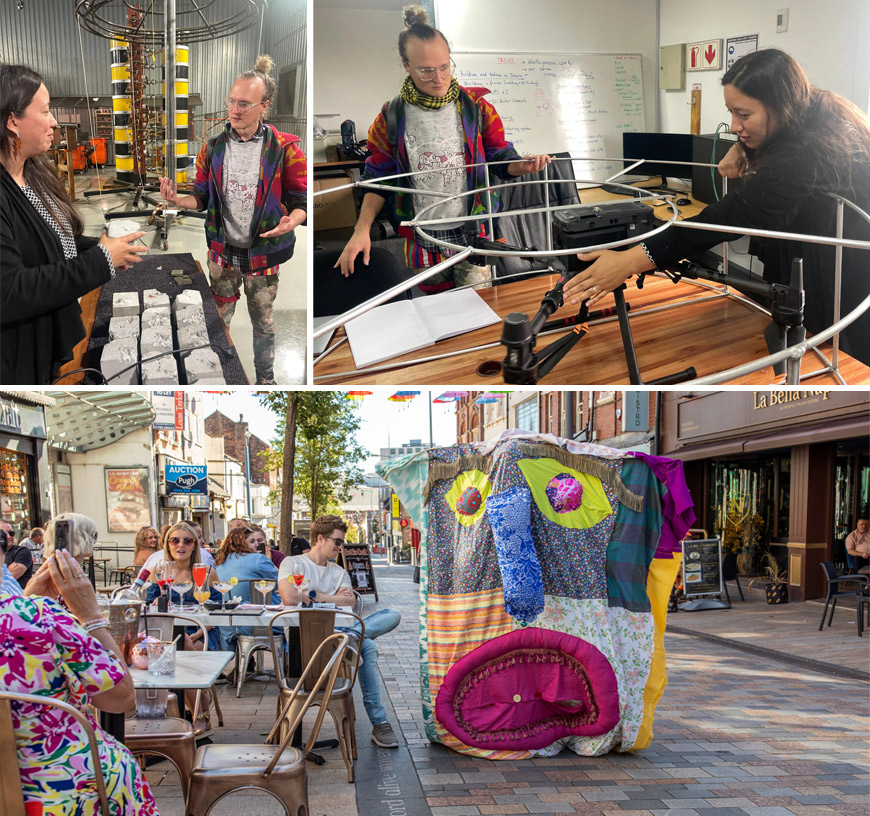– Wits Innovation Centre
WIC’s new Artist-in-Lab Fellow aims to create evocative art exploring the mysterious, inexplicable, and magical essence of lightning.
Dr Hugh Sillitoe is the newest Artist-in-Lab postdoctoral Fellow taking up a year-long fellowship in the Johannesburg Lightning Research Laboratory (JLRL) at Wits University.
His multifaceted, wide-reaching history as a researcher and innovative transdisciplinary artist sets him up for a colourful exploration of the intersections of art and science.

He is the third postdoc to take up the Artist-in-Lab residency hosted by the Wits Innovation Centre.
Professor Christo Doherty, Founder and Director of the Artist-in-Lab programme, says it “brings together artists and scientists and encourages them to explore questions and challenges from their different perspectives and using different practices. This allows a cross-pollination of ideas which can definitely lead to groundbreaking innovations as creative and analytic ideas and modes of thinking intersect.”
Sillitoe’s first impressions of the JLRL upon arriving in South Africa in November were amazement and curious confusion. “It’s similar to walking into an art installation,” he says. “Ultimately, as a layperson who has no idea what these machines are, you just think ‘Wow!”
The researcher and artist hopes to turn this initial awe for the force and complexity of lightning and lightning science into something that audiences can connect with. He has previously researched how absurd performance can be a political act and intends to explore this theme further in this context.
“I hope to make some really moving art that speaks to not only lightning, but also to this broader issue of the unfathomable, the inexplicable, and the magic.”
Sillitoe’s background of transitioning between various creative and academic fields as well as working in different cultural contexts around the world set him up uniquely for this.
The artist, who often works under the name Huge Sillytoe, grew up in Durham, England, and first explored art through music. “The punk movement (and subculture from the 1970s) has been a major influence on my artistic practice, politics, and my life in general,” he says. This interest led him to environmentalist activist movements which have informed his approach to art in an anti-hierarchical and anti-capitalist way.
For instance, as an artist in residence at the AirSpace Gallery in Stoke-on-Trent, in the United Kingdom in 2022 he created work, titled The Fool – How to do what we are not allowed to do. In this piece, he used large textile puppets and performances to explore the idea of jesters or pranksters and society’s dictative norms.
Sillitoe has worked across several countries in South America. For instance, a collaboration with the International Errorist movement in Buenos Aires in 2017 saw him performing as a mute, walking beard. This included the beard walking through the city distributing provocative questions around urban space.
His academic journey has led him to a PhD from the University of Glasgow that focused on absurd performance art practices in Buenos Aires and New York City. Before this, he completed an Interdisciplinary Master of Arts at the University of Chicago involving an ethnography of humour, play, and absurdity. In the past years, he has been an artist in residence at several institutions, including in Bolivia, Italy, and the United Kingdom.
“I’ve worked interdisciplinary between social sciences, the humanities, and the arts, as both a researcher and an artist, but this is my first kind of major collaboration with natural scientists,” Sillitoe says. He is excited to see his understanding of lightning unfold and to explore various artistic and academic opportunities within the residency.
Dr Hugh Hunt, Senior Lecturer in the School of Electrical and Information Engineering and the co-founder of the JLRL is excited to see what comes from the collaboration. He notes that since design thinking is such a large part of what they do, there is a significant overlap with the world of art. “So I think it’s not out of odds to have an artist come and work with us and experience the culture of our lab,” he says.
The JLRL does a variety of research, with some of it based on two high towers in Johannesburg that get stuck by lightning regularly. “So we are using the city as our laboratory, rather than a small-sized laboratory where you would do experiments in a more conventional sense.”
This is the third Artist-in-Lab Fellow, hosted by the Wits Innovation Centre. The first two residencies were in Structured Light Lab in the School of Physics. The fourth Artist-in-Lab Postdoctoral Fellow, Dr Warrick Swinney, will starting in January 2025 at the School of Architecture and Planning in the Faculty of Engineering and the Built Environment. Calls for applications are released bi-yearly through the Wits social media platforms.



